For years, people believed their hair destiny was written in their DNA — that if you inherited a certain gene, there was little you could do. But modern science tells a different story. 🧠✨
The emerging field of epigenetics reveals that genes are not fixed instructions, but responsive systems influenced by how we live, think, and even feel. Everything from your stress levels to your sleep, nutrition, and emotions can shape the way your genes behave.
And that includes the genes responsible for your hair growth. 🌱
Let’s explore how small daily choices can send powerful biological messages — and how understanding epigenetics can help you influence your body’s natural ability to regenerate.
🧬 What Is Epigenetics, and Why It Matters for Hair Growth
Your genes are not your destiny — they’re more like a piano waiting to be played 🎹.
Every thought, meal, or stressful moment sends signals that can “press” certain keys while leaving others silent. This is the essence of epigenetics — the science of how environment and lifestyle can change the way your genes express themselves without altering the DNA sequence itself.
According to the National Library of Medicine, epigenetics involves heritable and stable changes in gene expression that occur through modifications of the chromosome rather than changes to the genetic code. These modifications include DNA methylation, histone acetylation, and microRNA regulation, all of which act like molecular switches turning genes on or off — and these switches are highly sensitive to signals from your surroundings 🌍.
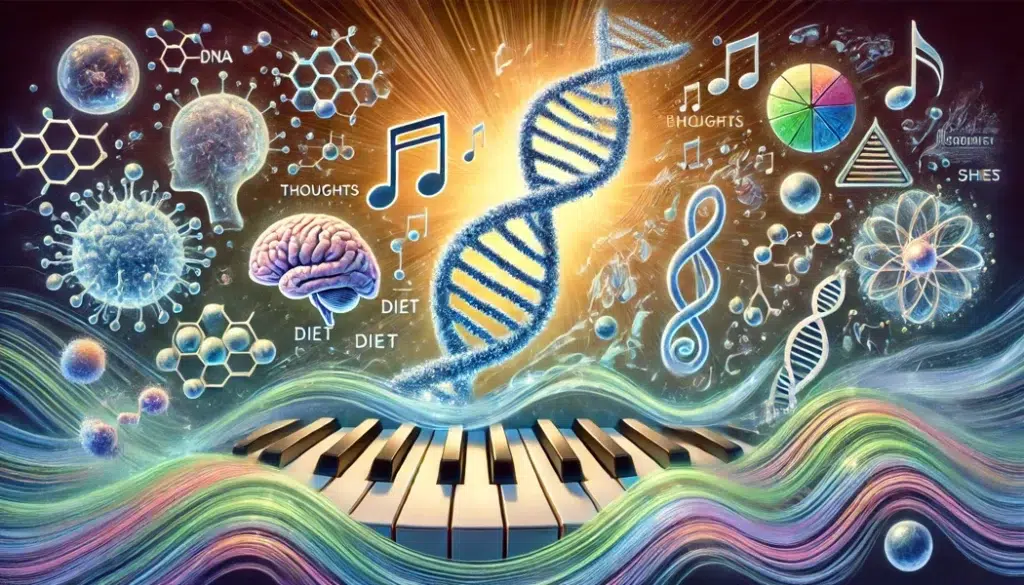
Research shows that lifestyle factors such as stress, diet, toxins, and even emotional states can influence these switches. As summarized by PMC, environmental and behavioral inputs can reshape methylation patterns, alter chromatin accessibility, and shift gene activity for months or even years. In other words, your daily habits talk directly to your genes 🧠.
This dynamic relationship becomes especially important for hair health. The Nature Communications review highlights how environmental signals can modify epigenetic mechanisms, creating long-term effects on tissue regeneration. For the scalp, these changes can determine whether hair follicle stem cells remain dormant or activate for new growth 🌱.
Studies on skin and follicular tissue add more clarity: epigenetic marks like DNA methylation and histone modifications regulate the genes responsible for follicle cycling and regeneration. In fact, research from the Icahn School of Medicine (Millar Lab) demonstrated that specific histone methylation patterns (such as H3K27me3) help maintain hair follicle stem-cell “stemness,” while removal of those marks triggers differentiation and new hair formation.
What this means for you: the way you live and think isn’t just shaping your mood or hormones — it’s literally shaping which genes in your hair follicles wake up to grow 🌞.
🧠 How Stress and Hormones Influence Gene Expression
When your body is under constant stress 😰, it releases high levels of cortisol — a hormone produced by the adrenal glands that helps you cope with challenges. Short bursts of cortisol can be useful, but chronic elevation gradually disrupts your internal balance, affecting everything from mood and immunity to — yes — hair follicles.
Scientific evidence shows that stress doesn’t just influence your emotions — it can actually reshape how your genes behave.
This happens through epigenetic mechanisms such as DNA methylation (adding or removing tiny chemical “tags” that silence or activate genes) and histone modification (changing the shape of the proteins that DNA wraps around).
A comprehensive review published in the Frontiers in Molecular Neuroscience confirms that psychological or physical stress can trigger lasting epigenetic marks, altering gene activity in multiple tissues — including skin and hair follicles.
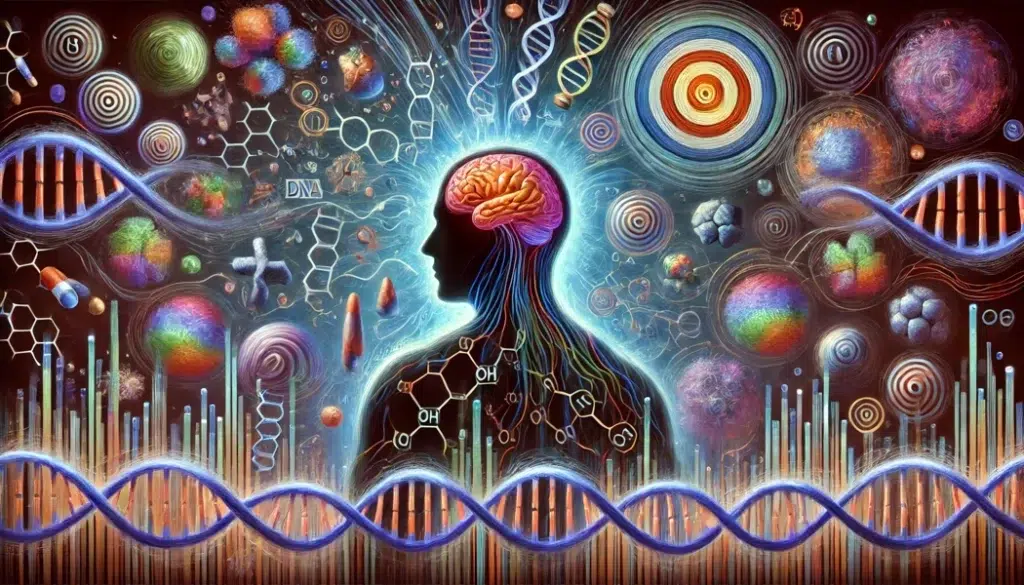
Cortisol also interacts with epigenetic regulators (molecules that modify how DNA is packaged within the cell nucleus).
According to research in the International Journal of Molecular Sciences, stress hormones can modify histones (the proteins around which DNA is wrapped), tightening or loosening the chromatin structure (the combined DNA–protein complex that determines gene accessibility).
This process controls which genes become “unlocked” for activation and which remain silent 🧬.
In simple terms — when stress becomes chronic, it can flip genetic switches that push hair follicles into rest instead of growth.
That’s why relaxation, meditation, and adaptogenic supplements may help restore balanced hormonal signaling and healthier epigenetic expression 🌿.
For a deeper look at how cortisol influences hair biology, check out our related article on Influence of Stress on Hair Growth.
🥦 Nutrition and Lifestyle as Epigenetic Switches
What you eat, how you move, and even how you sleep send continuous signals to your genes 🧠.
Epigenetics shows that nutrients can act as molecular messengers, influencing which genes are switched on or off through a process known as nutritional epigenomics (Advances in Nutrition).
Certain foods are rich in methyl donors — molecules that supply chemical groups used in DNA methylation (a chemical tag that can silence or activate genes).
Nutrients such as folate, vitamin B12, choline, and betaine — along with other B-vitamins — participate in the one-carbon metabolic pathway, which directly regulates methylation patterns and supports gene expression linked to cell repair, detoxification, and tissue growth (Frontiers in Neuroscience). 🌿
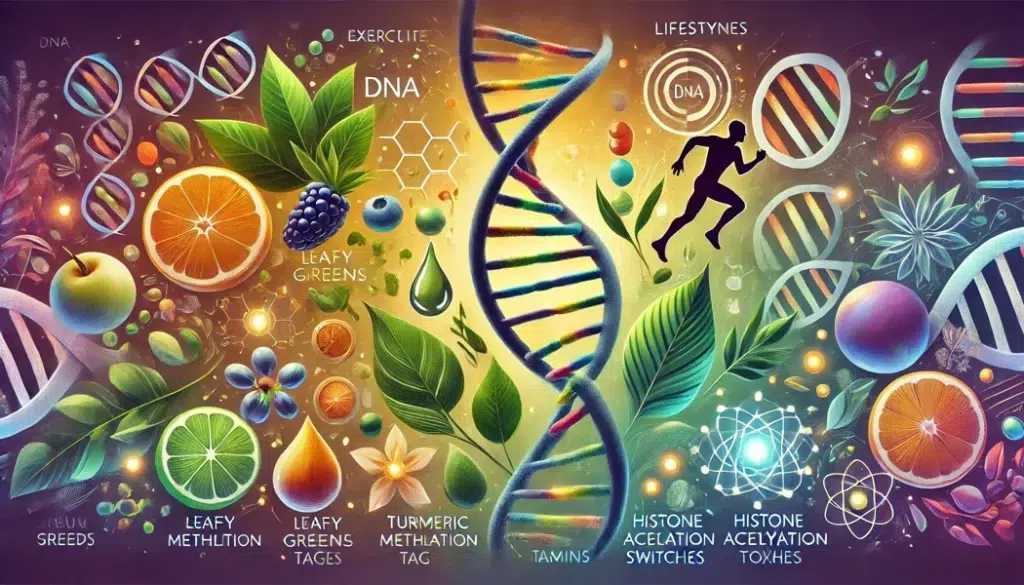
Antioxidant-rich foods like green tea, berries, and leafy greens help neutralize oxidative stress — an imbalance between free radicals and antioxidants — that can otherwise disturb healthy epigenetic signaling and accelerate follicle aging (Frontiers in Genetics).
Polyphenols such as EGCG from green tea, resveratrol from grapes, and curcumin from turmeric can influence histone acetylation (a modification that opens chromatin and promotes gene activation), thereby supporting cellular protection and longevity (International Journal of Molecular Sciences).
Lifestyle habits play a similar role. Regular physical activity, deep sleep, and limited exposure to environmental toxins help stabilize the epigenome (the chemical layer controlling gene activity without altering DNA itself).
Studies show that people who maintain consistent healthy routines exhibit more favorable epigenetic profiles — with improved stress regulation and better tissue regeneration (PMC). 🏃♂️😴
If you want to discover which foods best support hair strength and vitality, explore our guide on Best Food for Strong Hair. 🥑
🌱 Epigenetic Regulation Inside the Hair Follicle
Your hair follicles are tiny but remarkably intelligent structures — each one a living micro-organ that continuously senses and reacts to internal and external signals 🌿.
At the heart of this process are hair follicle stem cells (HFSCs) — specialized cells responsible for regenerating new strands during every growth cycle.
These cells don’t just follow genetic instructions blindly. They respond to epigenetic markers, such as DNA methylation and histone modifications (chemical tags that turn genes on or off without altering DNA itself).
According to the Experimental Dermatology review, changes in DNA methylation within the follicle can determine whether stem cells remain dormant or activate to start a new growth phase.
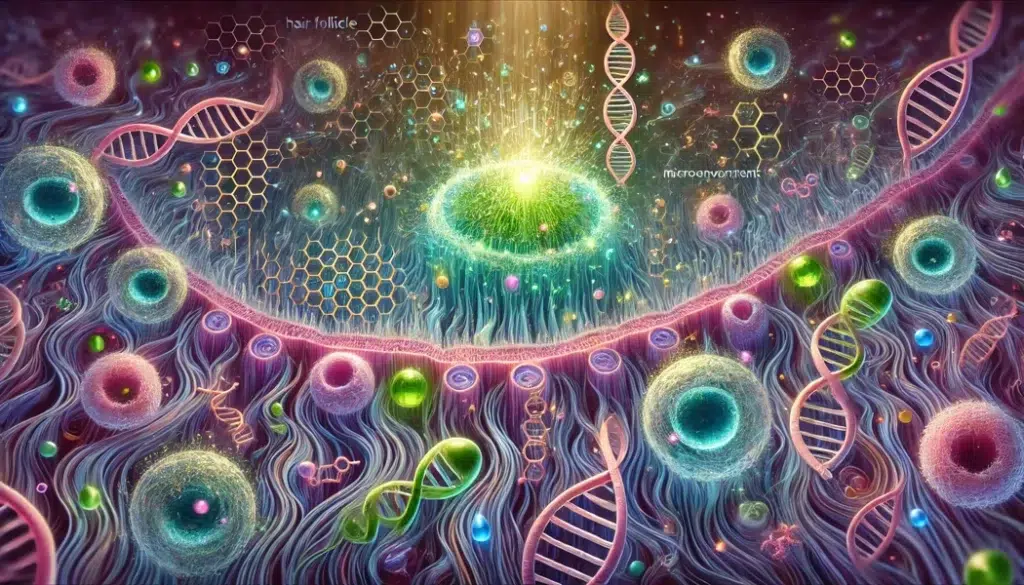
Research from the Millar Lab, Icahn School of Medicine highlights that specific histone methylation patterns — particularly H3K27me3 — help maintain HFSC “stemness” (their regenerative potential). When these marks are removed, the cells shift into differentiation, forming new keratinocytes and hair shafts.
In simpler terms, the “epigenetic memory” of your hair follicle decides whether it stays in rest or wakes up for renewal.
Disturbances such as chronic inflammation, hormonal imbalance, or oxidative stress can alter this memory, pushing the follicle toward miniaturization or dormancy.
However, this same mechanism can also work in your favor 🌞.
Emerging research shows that by improving blood circulation, reducing chronic stress, and providing key nutrients, you can create a healthier epigenetic microenvironment — the biochemical setting that determines how genes within the follicle are expressed.
This supportive environment allows hair follicle stem cells to behave more like young, active cells capable of renewal and growth (Frontiers in Cell and Developmental Biology, PubMed Central).
For instance, the principles behind follicular reactivation are also explored in advanced regenerative treatments such as PP405 Hair Follicle Botox — an approach designed to stimulate cellular renewal and restore vitality from within.
🌞 Can We “Turn On” Hair Growth Genes Naturally?
The short answer is: yes — but it’s not magic, it’s biology. ✨
Epigenetics teaches us that while you can’t change your DNA sequence, you can influence how your genes behave. This means that many of the same genes that slow down or “switch off” with age, stress, or inflammation can be gently reactivated through consistent lifestyle and care choices.
Studies have shown that certain natural compounds — such as polyphenols, omega-3 fatty acids, zinc, and biotin — can modulate epigenetic markers that regulate cell growth and inflammation in the scalp (ScienceDirect).
These nutrients promote methylation balance and histone acetylation, processes that “open up” chromatin and make growth-related genes more active.
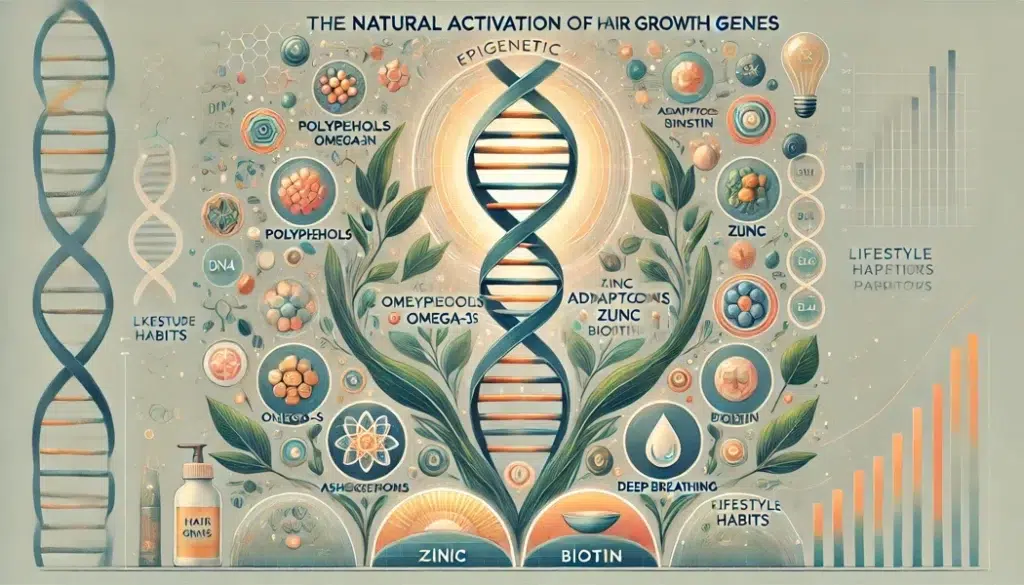
At the same time, adaptogens like Rhodiola, Ashwagandha, and Panax Ginseng have been shown to reduce cortisol and improve cellular resilience — both of which support healthier gene expression in the follicles (National Library of Medicine). 🌿
When paired with stress-reducing habits such as mindfulness or breathing techniques, the effect can be even stronger.
This “gene awakening” process is gradual, but very real. Your body constantly listens to biochemical cues — nutrition, hormones, oxygen flow, and mental state. When these signals turn positive, stem cells in the follicle are more likely to re-enter the active growth phase (anagen). That’s why combining inner and outer care produces visible results over time.
💧 Recommended Science-Based Solutions
To naturally support this process and keep your follicular environment healthy, explore products that combine proven ingredients with holistic benefits:
– Hair Growth Conditioner + Scalp Massager
– Hair Growth Shampoo
– Anti-Stress Supplement
– Hair Growth Supplement
– LLLT Device
Each of these tools can help reinforce the same biological pathways discussed here — improving circulation, nutrient delivery, and epigenetic balance at the follicular level.
🌟 Conclusion: Reprogramming Your Hair from Within
Your DNA is not a prison — it’s a language that your body constantly rewrites through signals, nutrition, thoughts, and emotions 🌱.
Epigenetics proves that the same biological systems once thought to be fixed can be reprogrammed through everyday choices. Every meal, breath, and mindset shift sends new instructions to your cells, shaping how your genes behave and how your follicles renew themselves.
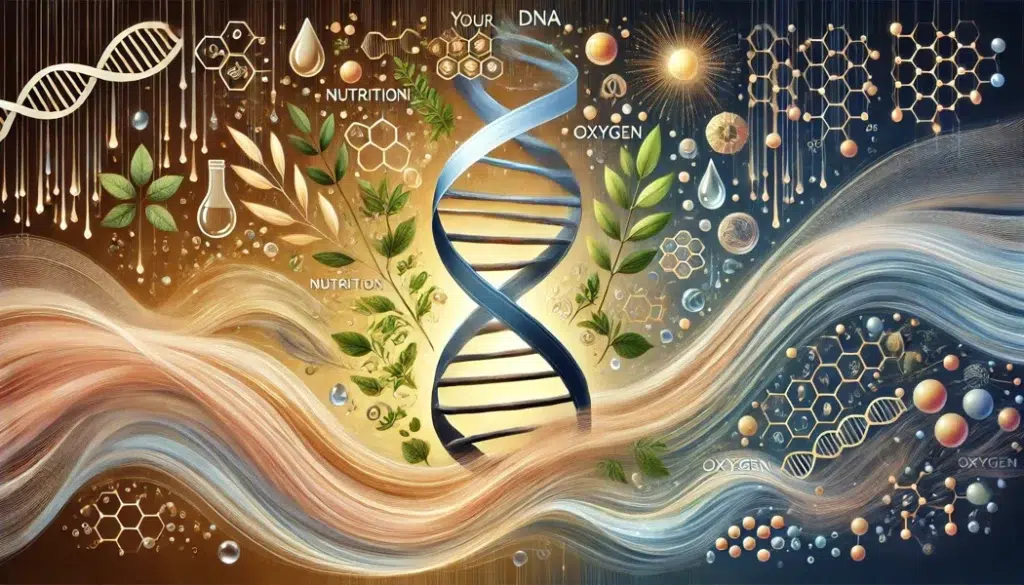
When you combine science-backed nutrition, balanced hormones, stress reduction, and mindful living, you’re not just caring for your hair — you’re communicating with it. 🧠✨
Your follicles listen to your internal environment. If you feed them calm, oxygen, and the right nutrients, they respond with growth, shine, and resilience.
True transformation takes consistency, not miracles.
Small, repeated signals — good sleep, hydration, gentle scalp care, adaptogenic support — gradually reset your biological rhythm. Over time, those micro-changes add up, and the mirror begins to reflect the harmony you’ve built inside.
So, instead of fighting genetics, work with them.
Every mindful action, every healthy choice, every stress you dissolve — they all speak to your genes and tell them: “Grow.” 🌿
Stay with us — the best is yet to come.
By following our advice, you’re doing the most you can for your hair.
Be the first to know when we publish new guides, tests, and proven strategies for stronger, healthier hair.
👉 Visit the About Me page to learn more about my journey, mission, and why helping people with hair health is so personal to me.
Want healthier, stronger hair? Discover 8 science-backed habits that protect your scalp and boost natural growth. Get your free PDF guide today!
Disclaimer: This article is for informational purposes only and is not a substitute for professional medical advice. Sensitive claims are supported with scientific references, and full product details can always be found on the official websites of the respective manufacturers or distributors.
Some links in this article are affiliate links. If you choose to make a purchase through them, I may earn a small commission at no extra cost to you — helping me keep HairGrowGenius running. Thank you for your support!

❓ FAQ: Epigenetics & Hair Growth
🧬 Can lifestyle really “switch on” hair growth genes?
Yes. Lifestyle signals — like nutrition, sleep, stress levels, and physical activity — influence epigenetic marks such as DNA methylation and histone acetylation. When these signals are positive, follicles are more likely to enter the anagen (active growth) phase and maintain their youthful stem-cell behavior over time. 🌿
⏳ How long does it take to notice results from epigenetic changes?
Epigenetic responses begin immediately at the cellular level, but visible hair changes are gradual. Most people need 8–12+ weeks of consistent healthy habits — balanced nutrition, stress reduction, and scalp care — to notice improved density, texture, or reduced shedding. 🪞
💪 Which daily actions give the biggest epigenetic boost for hair?
Prioritize deep sleep (7–9 h), anti-inflammatory foods (rich in protein, omega-3s, folate, and polyphenols), regular exercise, and stress management (breathing, mindfulness, adaptogens). Combine that with gentle scalp care to enhance circulation and reduce oxidative stress. 🌱
🧠 References
1. National Library of Medicine — Epigenetics Overview.
https://www.ncbi.nlm.nih.gov/books/NBK532999/
(Accessed: October 2025)
2. PubMed Central (PMC) — Environmental and Behavioral Epigenetics: How Lifestyle Shapes Gene Activity.
https://pmc.ncbi.nlm.nih.gov/articles/PMC3752894/
(Accessed: October 2025)
3. Nature Communications — Environmental Influence on Epigenetic Mechanisms and Tissue Regeneration.
https://www.nature.com/articles/s42003-021-02316-6
(Accessed: October 2025)
4. Millar Lab, Icahn School of Medicine — Committing to a Hairy Fate: Epigenetic Regulation of Hair Follicle Stem Cells.
https://labs.icahn.mssm.edu/millarlab/wp-content/uploads/sites/309/2019/09/Committing-to-a-Hairy-Fate-Epigenetic-Regulation-of-Hair-Follicle-Stem-Cells.pdf
(Accessed: October 2025)
5. Frontiers in Molecular Neuroscience — Stress-Induced Epigenetic Modifications in the Brain and Peripheral Tissues.
https://pmc.ncbi.nlm.nih.gov/articles/PMC10177343/
(Accessed: October 2025)
6. International Journal of Molecular Sciences — Stress Hormones and Histone Modifications: Linking Cortisol to Epigenetic Regulation.
https://pmc.ncbi.nlm.nih.gov/articles/PMC8198182/
(Accessed: October 2025)
7. Advances in Nutrition — Nutritional Epigenomics: How Food Components Regulate Gene Expression.
https://pmc.ncbi.nlm.nih.gov/articles/PMC3262611/
(Accessed: October 2025)
8. Frontiers in Neuroscience — One-Carbon Metabolism, Methylation, and Gene Regulation.
https://pmc.ncbi.nlm.nih.gov/articles/PMC6471069/
(Accessed: October 2025)
9. Frontiers in Genetics — Antioxidants and Epigenetic Regulation under Oxidative Stress.
https://pmc.ncbi.nlm.nih.gov/articles/PMC7565986/
(Accessed: October 2025)
10. International Journal of Molecular Sciences — Polyphenols, Histone Acetylation, and Cellular Longevity.
https://pmc.ncbi.nlm.nih.gov/articles/PMC9570183/
(Accessed: October 2025)
11. Experimental Dermatology — DNA Methylation Dynamics in Hair Follicle Stem Cells.
https://onlinelibrary.wiley.com/doi/10.1111/exd.12488
(Accessed: October 2025)
12. Frontiers in Cell and Developmental Biology — Epigenetic Microenvironment in Hair Follicle Regeneration.
https://www.frontiersin.org/articles/10.3389/fcell.2020.605784/full
(Accessed: October 2025)
13. PubMed Central — Epigenetic Modulation and Hair Follicle Stem Cell Activation.
https://pmc.ncbi.nlm.nih.gov/articles/PMC3794757/
(Accessed: October 2025)
14. ScienceDirect — Natural Compounds Modulating Epigenetic Pathways: Implications for Hair Growth and Inflammation.
https://www.sciencedirect.com/science/article/pii/S1016847823002972
(Accessed: October 2025)
15. National Library of Medicine (PMC) — Adaptogens, Cortisol Reduction, and Cellular Resilience.
https://pmc.ncbi.nlm.nih.gov/articles/PMC6240259/
(Accessed: October 2025)
🧩 Every reference listed here comes from peer-reviewed scientific research, carefully chosen to give you reliable, evidence-based insight into how epigenetics shapes your hair’s regenerative potential.
🧩 Every reference listed here comes from peer-reviewed scientific research, carefully chosen to give you reliable, evidence-based insight into how epigenetics shapes your hair’s regenerative potential.

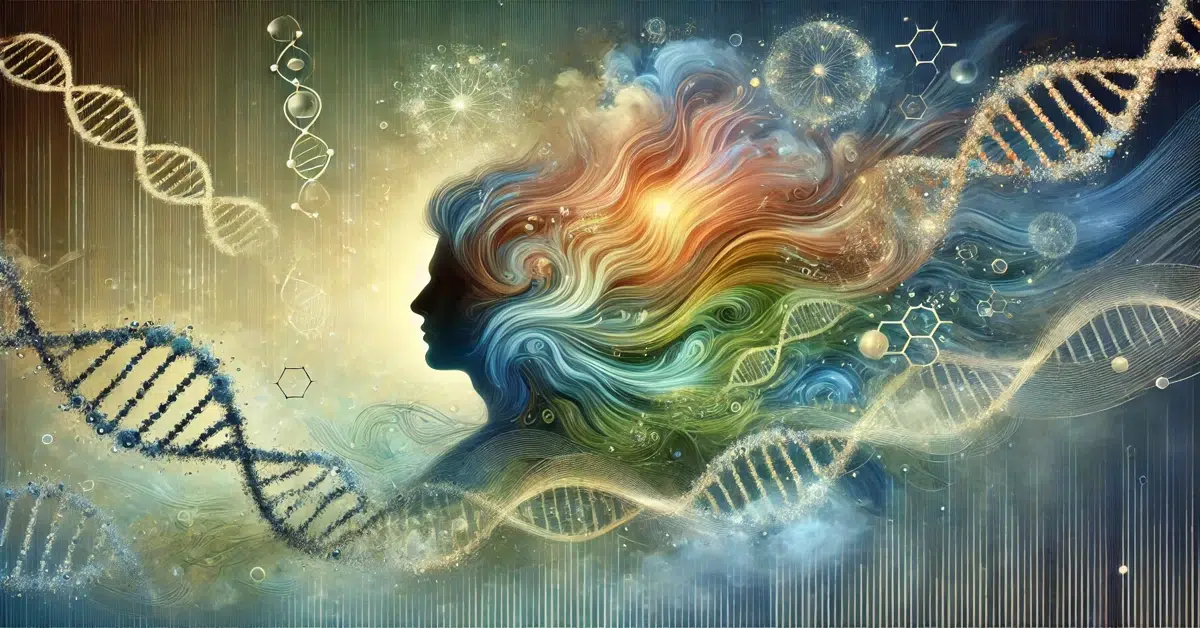
Leave a Reply